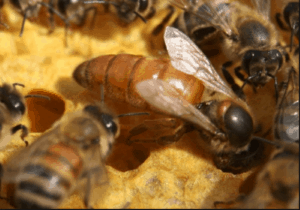A swarm of bees can be an alarming presence. They tend to swarm around any object they can find, and sometimes it can be very difficult to remove a bee swarm. So if this is something you’re concerned about – or dealing with – you’ll want to pay close attention.
A swarm of bees will usually form when a hive – or a queen – is destroyed. The bees form a type of mobile hive, and they congregate in that location until they can find a new hive location.
So let’s dive right in, and take a look at how you should manage a swarm of bees.
Table of Contents
What do you do with a bee swarm?
Seeing a swarm of bees is something that will cause panic to settle in. We get that, and seeing such a massive swarm of bees can be horrifying. Now, while it may appear to be a dangerous situation, you might be surprised by how you should deal with the situation.
So what should I do if I encounter a bee swarm?

If you do encounter a bee swarm, while you might be scared, you have to understand that the bees are too. They’re only looking for a home, which is their priority when swarmed so they won’t cause you any trouble. So to keep things simple, the best way to deal with a swarm of bees is to leave them be (no pun intended).
So while a swarm of bees may seem dangerous, the likelihood that they’ll attack you is actually very low. All they’re doing is searching for a home, so letting do will solve the problem on it’s own.
What causes bee swarming?
When you see a swarm of bees you’ll probably be quite shocked. They can reach massive sizes, and to be blunt, they’re really terrifying up close. So if you see one, once you take it all in, you’ll probably be curious as to why a swarm may have formed in your area.
Their colony has been destroyed
If a queen bee, or a colony gets disabled, this is one of the main reasons bees will swarm. This is due to the fact that most of the bees will flee the hive, and in doing so, look for a new location to call home. The process takes quite a bit of time, but usually they find one quick. This is due to the fact that an exposed swarm is vulnerable one, which means finding a new home is their top priority.
They’re looking to establish another colony
If a bee colony is thriving, and it grows too large, bees will actually attempt to setup a second location. This will keep the primary colony from becoming too large, and create a second colony altogether. The bees will then swarm somewhere, and determine where a good location for a colony is.
They’re robbing another hive in the area
This is a bit more rare, but this does actually happen. In some cases bees may swarm in order to begin robbing another hive. When this happens, the bees might stick around for quite a while. This is due to the fact that they may be low on resources, so in order to survive they need to raid another hive.
How long do bee swarms stay active?
If you encounter a bee swarm, and it seems to be sticking around, you’ll probably want to know how long it will be there. Luckily, there is actually some pretty good evidence out there about how long these swarms tend to stick around. So let’s take a look.
Sometimes they’re quick
If you manage to get lucky, the swarm of bees will actually dissipate quickly. This happens when bees know where they’ll be going, but they need to hangout for a few minutes to collect themselves. So on the quick side, if you manage to get lucky, a swarm of bees will be on their way a couple of minutes or up to an hour.
Sometimes it can take a while
If you notice that a bee swarm is there for more than a day, they might be there for the long haul. This is due to the fact that sometimes bees can actually remain in their swarm for up to 5 days. This usually occurs if they struggle to find a new location, or if they’ve recently lost a queen. Plus, depending on certain conditions, these swarms can last even longer.
So when it comes to dealing with bee swarms, it’s really a flip of a coin. This is due to the fact that a bee swarm can last between 5 minutes and about 5 days on average. So when dealing with a swarm, you better hope you get lucky.
How do you know when a bee is going to swarm?
If you see a few bees huddled together, you might be wondering whether or not they’re going to swarm. This is a natural fear, and we get why a few bees hanging around may make you nervous. Luckily, we have the answers for you.
The time of year
The time of year actually has a lot to do with this whole process. This is due to the fact that bees will usually attempt to find new colonies during the warmer months when they’re able to move freely. So if you see a group of bees in the late spring or early summer, it might be a sign that they’re going to start swarming.
The time of day
Another great way to determine whether or not they’ll swarm is the time of day. This is due to the fact that bees usually swarm during the late hours of the day. So if you see a collection of bees before the sun is going down, there is a good chance that there might be a swarm there in the morning.
So if you’re in the late spring, or early summer, the bees have a pretty good chance of swarming if you see them in a group. Plus, if it’s later in the day, the chances of bees swarming will also be much greater.
Bee swarm removal
Now that you know a little bit about bee swarms, you’ll want to know about how to get rid of them. As we’ve mentioned earlier, they may leave in hours, but what if they stick around for days? In that case you might not have time to be patient, which means you’ll need to act quickly. So let’s take a look at a few ways to handle a bee swarm.
Locate and remove the honeycomb
Bees will always create a honeycomb to swarm around. This will act as their temporary base of operations, and will usually have a queen nearby. If you think you can handle this on your own, it might be a good idea to remove the honeycomb from the swarm. Not only will this cause the bees to flee, but it should keep them from swarming there again as well.
Call a beekeeper
Bees are essential to many ecosystems, and as you may already know they’re not doing as well as they used to. So if you want to handle this swarm without harming the bees themselves, it might be time to call an exterminator. Not only will this help the bees get somewhere else safely, but it’s also the best way to handle the situation. You won’t get stung, and the bees live, it’s a win-win situation!
Use a swarm trap or box
If you want to handle your situation on your own, without removing the honeycomb, it might be time to break out the swarm box. This clever device will allow you to trap the bees, and in doing so will actually allow you to move the swarm to a new location. The only downside to this method is that it might attract bees from other hives. So if you do go this route, just be sure to be a bit careful. Always seek professional advice first.
So as you can see, there are plenty of ways to handle a swarm of bees. You can either call a professional to have it done for you, but if you have the guts you can do it on your own. Whichever method you choose, just always remember to be careful. Plus, if you’re allergic, it’s always best to use a professional.
What to do after catching a swarm of bees
If you do happen to catch a swarm of bees, and you like the idea of caring for them, there are a few things that you can do. So for you future beekeepers out there, this is the section for you. Let’s take a look.
Create your own swarm box
You can find pre-made equipment online, but if you do plan on keeping then for a while, you might want to cut and make your own box. You’ll need some tools, like a handsaw, but the process will be well worth it. Once you have the box, you can lure them in or move them on your own. Now, if you do plan on moving them on your own, you’ll need to make sure that you have the right equipment to do so.
Leave them alone for a little while
If you do plan on keeping these bees for the long haul, you’ll want to make sure that they can be self sufficient. This means that you’ll want to let them do their thing for a couple of days. Once you notice that they’re hanging in there, it’s time to start moving onto the next step.
Sugar water
Once the bees have managed to become self sufficient, it’s time to make sure that they’re okay. A great way to do this is by providing them with sugar water. Not only will this help them in the short-term, but it will make sure that the swarm will be okay in the long-term as well.
Find a safe place to release them
If you don’t want to keep the bees, but don’t want to harm them either, you’ll want to release them in a safe location. You can either call a beekeeper for this, or you can scout out some great locations on your own. Always keep in mind that bees love trees or fields.
If you do manage to catch a swarm of bees, the process can be quite amazing. It all depends on what you want to do with the bees, but making sure they have what they need to survive before releasing them is always a good idea.
Bee swarming signs
Finally, the final thing we want to leave you with are the signs of a potential bee swarm. Sometimes it’s a good idea to know what you’re dealing with before it happens, so you’ll definitely want to pay close attention to this section. Let’s take a look.
A lot of drones in the area
If you notice a big increase in drone activity, it might be a warning sign that a bee swarm is going to swarm. This is usually the first sign, and this can occur before you notice hive cells being formed in the potential location. So be sure to keep an eye out for an increase in the bee population.
You can see the queen

The queen bee usually remains within the hive, and for this reason many people don’t even know what a queen bee looks like. Therefore, if you notice an unusually sized bee hanging around, it might be the queen. Now, if you do see this queen, there is a very good chance that she is picking the location for a potential swarm.
You notice hive cells forming

Hive cells are those little hexagons you may see forming around a branch. If you notice these cells being built in your area, that’s a very good sign that a swarm is on it’s way. Along with this, if you notice an increase in eggs in the area, it’s also another sign that a swarm might be swarming.
If you happen to notice any of these signs in your area, it might be time to start thinking about how to deal with a swarm of bees.
Summary
We know that we went over quite a bit of information today, but we want to make sure that you’re well informed. If you have any questions, or find yourself lost the next time you find a swarm, please feel free to use this article as a guide. Dealing with a swarm of bees doesn’t need to be difficult, you just need to know how to handle the situation from start to finish.
If you care about the safety of bees, always be sure to use a beekeeper when handling this situation. If you tackle it in a different way it can cause harm to the swarm, which will eventually lead to the death of that swarm. Therefore, when dealing with bees, we always recommend a beekeeper.
Now that you know the facts, and how to handle a swarm of bees, how will you deal with your next swarm?
